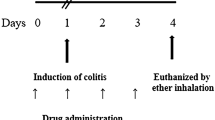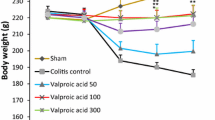Abstract
Intrarectal administration of 4% acetic acid produces diffuse inflammation that ultimately results in erosions and ulcerations of the rat colon. Although this model of colitis has been used extensively over the past several years, there are no quantitative data available regarding the relationship between neutrophil infiltration and mucosal injury during times of active inflammation. Therefore, the objective of this study was to define the role of extravasated neutrophils as mediators of mucosal injury and inflammation in acetic acid-induced colitis. We found the intrarectal administration of 4% acetic acid produced an 11-fold increase in colonic mucosal permeability, a 9-fold increase in colonic MPO activity, and a 1.6-fold increase in colon weight at 48 h following administration of acetic acid. In addition, we found significant correlations between colonic MPO activity and mucosal permeability and between colonic MPO activity and colon weight (P < 0.01 for both). These data suggested that inflammatory neutrophils may mediate mucosal injury and inflammation in this model of colitis. To assess the role of circulating neutrophils, rats were rendered neutropenic for 48 h by the intraperitoneal administration of antiserum directed toward rat neutrophils (ANS). Although ANS treatment reduced both the number of circulating neutrophils and colonic MPO activity to less than 10% of control values, it did not attenuate the increases in colonic mucosal permeability nor did it attenuate the increases in colon weight produced by acetic acid. Histological inspection confirmed that ANS treatment was not effective in attenuating the injury to the epithelial barrier. These data demonstrate that infiltrating neutrophils do not mediate the mucosal injury and inflammation observed in acetic acid-induced colitis.
Similar content being viewed by others
References
Riddell, R. H. 1988. Pathology of idiopathic inflammatory bowel disease.In Inflammatory Bowel Disease. J. B. Kirsner and R. G. Shorter, editors. Lea and Febiger, Philadelphia. 329–350.
Fretland, D. J., D. L. Widomski, B. Tsai, J. M. Zemaitis, S. Levin, S. W. Djuric, R. L. Shone, andT. S. Gaginella. 1990. Effect of the leukotriene B4 receptor antagonist SC-41930 on colonic inflammation in rat, guinea pig and rabbit.J. Pharmacol. Exp. Ther. 255:572–575.
Grisham, M. B., andD. N. Granger. 1988. Neutrophil-mediated mucosal injury: Role of reactive oxygen metabolites.Dig. Dis. Sci. 33(suppl):6S-15S.
Yamada, T., andM. B. Grisham. 1991. The role of granulocyte-derived oxidants in intestinal mucosal injury.In Effects of Immune Cells and Inflammation on Smooth Muscle and Enteric Nerves. W. J. Snape and S. M. Collins, editors. CRC Press, Boca Raton. 295–303.
Klebanoff, S. J. 1988. Phagocytic cells: Products of oxygen metabolism.In Inflammation: Basic Principles and Clinical Correlates. J. I. Gallin, I. M. Goldstein, and R. Snyderman, editors. Raven Press, New York. 391–444.
Weiss, S. J. 1989. Tissue destruction by neutrophils.N. Eng. J. Med. 320:365–376.
Strober, W. 1985. Animal model of inflammatory bowel disease — an overview.Dig. Dis. Sci. 30(suppl.):3s-10s.
Zeitlin, I. J., and A. A.Norris. 1983. Animal models of colitis.In Mechanism of Gastrointestinal Inflammation. BSG/SK&F International Workshop, editor. Stanstead Abbotts. 70–73.
Fitzpatrick, L. R., J. S. Bostwick, M. Renzetti, R. G. Pendleton, andD. L. Decktor. 1990. Antiinflammatory effects of various drugs on acetic acid induced colitis in the rat.Agents Actions 30:393–402.
MacPherson, B. R., andC. J. Pfeiffer. 1978. Experimental production of diffuse colitis in rats.Digestion 17:135–150.
Sekizuka, E., M. B. Grisham, M. Li, E. A. Deitch, andD. N. Granger. 1988. Inflammation-induced intestinal hyperemia in the rat: Role of neutrophils.Gastroenterology 95:1528–1534.
Sharon, P., andW. F. Stenson. 1985. Metabolism of arachidonic acid in acetic acid colitis in rats.Gastroenterology 88:55–63.
Fedorak, R. N., L. R. Empey, C. MacArthur, andL. D. Jewell. 1990. Misoprostol provides a colonic mucosal protective effect during acetic acid-induced colitis in rats.Gastroenterology 98:615–625.
Yamada, T., R. D.Specian, D. N.Granger, T. S.Gaginella, and M. B.Grisham. 1991. Misoprostol attenuates the acetic acid-induced increases in colonic mucosal permeability and inflammation: Role of blood flow.Am. J. Physiol. (Gastrointest. Liver Physiol.) (in press).
Sharon, P., andW. F. Stenson. 1984. Enhanced synthesis of leukotriene B4 by colonic mucosa in inflammatory bowel disease.Gastroenterology 86:453–460.
Sandler, H., H. Hogstorp, C. Lundberg, andB. Gerdin. 1987. Antiserum-induced neutropenia in the rat: Characterization of a rabbit anti-rat neutrophil serum.Br. J. Exp. Pathol. 68:71–80.
Crissinger, K. D., P. R. Kvietys, andD. N. Granger. 1990. Pathophysiology of gastrointestinal mucosal permeability.J. Intern. Med. 228(suppl. 1):145–154.
Von Ritter, C., E. Sekizuka, M. B. Grisham, andD. N. Granger. 1988. The chemotactic peptideN-formyl methionyl-leucyl-phenylalanine increases mucosal permeability in the distal ileum of the rat.Gastroenterology 95:651–656.
Grisham, M. B., J. N. Benoit, andD. N. Granger. 1990. Assessment of leukocyte involvement during ischemia and reperfusion of intestine.Methods Enzymol. 186:729–741.
Itoh, M., andP. H. Guth. 1985. Role of oxygen-derived free radicals in hemorrhagic shockinduced gastric lesions in the rat.Gastroenterology 88:1162–1167.
Kvietys, P. R., B. Twohig, J. Danzell, andR. D. Specian. 1990. Ethanol-induced injury to the rat gastric mucosa.Gastroenterology 98:909–920.
Smith, S. M., L. Holm-Rutili, M. A. Perry, M. B. Grisham, K. Arfors, D. N. Granger, andP. R. Kvietys. 1987. Role of neutrophils in hemorrhagic shock-induced gastric mucosal injury in the rat.Gastroenterology 93:466–471.
Wallace, J. L., C. M. Keenan, andD. N. Granger. 1990. Gastric ulceration induced by nonsteroidal anti-inflammatory drug is a neutrophil-dependent process.Am. J. Physiol. 259(Gastrointest. Liver Physiol. 22):G462-G467.
Morris, G. P., P. L. Beck, M. S. Herridge, W. T. Depew, M. R. Szewczuk, andJ. L. Wallace. 1989. Hapten-induced model of chronic inflammation an ulceration in the rat colon.Gastroenterology 96:795–803.
Wallace, J. L., andC. M. Keenan. 1990. Leukotriene B4 potentiates colonic ulceration in the rat.Dig. Dis. Sci. 35:522–629.
Wallace, J. L., W. K. MacNaughton, G. P. Morris, andP. L. Beck. 1989. Inhibition of leukotrienes synthesis markedly accelerates healing in a rat model of inflammatory bowel disease.Gastroenterology 96:29–36.
Author information
Authors and Affiliations
Additional information
This work was supported by grants from the NIH (DK39168), Crohn's and Colitis Foundation of America and Pharmacia LEO Therapeutics (Uppsala, Sweden).
Rights and permissions
About this article
Cite this article
Yamada, T., Zimmerman, B.J., Specian, R.D. et al. Role of neutrophils in acetic acid-induced colitis in rats. Inflammation 15, 399–411 (1991). https://doi.org/10.1007/BF00917356
Issue Date:
DOI: https://doi.org/10.1007/BF00917356




